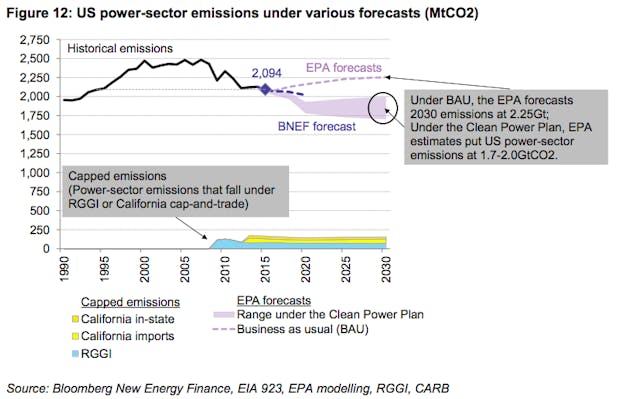In 2015, Republicans’ dire warnings of the war on coal may finally come true. The country is on track to see “the largest wave of coal retirements in U.S. history,” while renewables will see an exceptional year, according to a Bloomberg New Energy Finance (BNEF) report released Thursday.
BNEF forecasts that greenhouse gas emissions from the U.S. electricity sector will drop 16 percent over 2005 levels, marking their lowest point in two decades (a 2 percent difference from 2014 to 2015). While 7 percent of coal power will shut down, wind and solar will see a year of record growth, at 18.5 megawatts.
The reasons why this is happening are more important than the numbers, per se. Policies intended to cut the U.S.’s carbon footprint are working as planned, by permanently transforming electricity into a greener sector. Emissions year-to-year always fluctuate, and normally that’s driven by cyclical factors such as weather trends and economic strength. For example, a record 4.7 percent drop in the power sector from 2011 to 2012 followed a mild winter; the next year, emissions once again rose.

This year is different, because federal policies are driving the change. It's also a watershed year because of the timing of various environmental policies, such as clean energy subsidies and coal regulation.
First, an air pollution rule that tackles mercury and other toxic pollution from power plants is set to take effect in a matter of weeks. This regulation has nothing to do with climate change, other than the pressure it puts on the oldest, dirtiest coal plants. This is an “artificial deadline” affecting coal plants “whose economics were already challenged,” the report notes. (This deadline could change, however, as the Supreme Court is considering a case on the regulation’s future.). Second, renewable energy subsidies—specifically a subsidy for wind production and another for solar—are set to phase out in the next two years. Though this hurts growth in the long-run, the deadline means there is a rush to install clean energy before tax credits end.
Finally, natural gas continues to grow, and BNEF’s analysis expects gas to pick up where coal falls short.
As the Washington Post's Chris Mooney notes, these are incremental changes, meaning our electricity is still coming from the usual suspects—coal, followed by natural gas, nuclear energy, and renewables. The Environmental Protection Agency’s plan to require additional cuts from the power sector will mean even more adoption of renewables and natural gas. Over time, these policies cut the electricity sector’s roughly 40 percent contribution to U.S. carbon pollution.
You can see that change in the shaded scenario that BNEF and the EPA predict compared to what emissions would be in the business-as-usual case (the dashed purple line):

The United States isn’t the only national power sector going through transformation. Last year China’s emissions fell for the first time since 2001. Even more encouragingly, global carbon emissions from electricity didn’t increase, the first time in recent history that this did not happen because of an economic downturn.
With a few more years like this one, we might even get to declare victory against coal.
